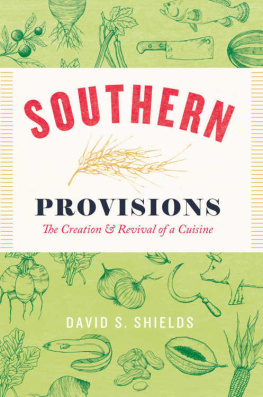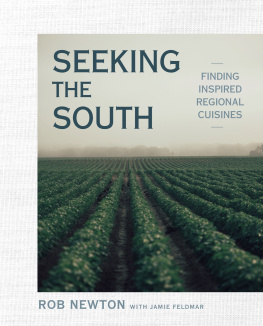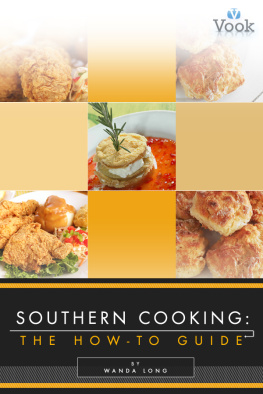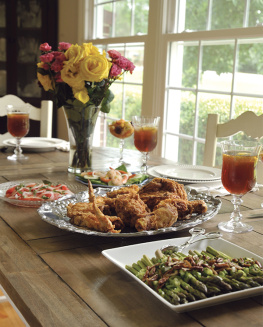SOUTHERN PROVISIONS
The Creation & Revival of a Cuisine
DAVID S. SHIELDS

The University of Chicago Press
Chicago and London
DAVID S. SHIELDS is the McClintock Professor of Southern Letters at the University of South Carolina and chairman of the Carolina Gold Rice Foundation. His other books include Still: American Silent Motion Picture Photography, also published by the University of Chicago Press.
The University of Chicago Press, Chicago 60637
The University of Chicago Press, Ltd., London
2015 by The University of Chicago
All rights reserved. Published 2015.
Printed in the United States of America
24 23 22 21 20 19 18 17 16 15 1 2 3 4 5
ISBN -13: 978-0-226-14111-4 (cloth)
ISBN -13: 978-0-226-14125-1 (e-book)
DOI : 10.7208/chicago/9780226141251.001.0001
The interior illustrations are by Lauren Nassef.
Library of Congress Cataloging-in-Publication Data
Shields, David S., 1951 author.
Southern provisions: the creation and revival of a cuisine / David S. Shields.
pages cm
Includes bibliographical references and index.
ISBN 978-0-226-14111-4 (cloth: alkaline paper) ISBN 0-226-14111-X (cloth: alkaline paper)
ISBN 978-0-226-14125-1 (e-book) ISBN 0-226-14125-X (e-book)
1. Cooking, AmericanSouthern styleHistory. 2. GastronomySouthern StatesHistory. 3. CookingSouthern StatesHistory. I. Title.
TX633.S55 2015
641.5975dc23
2014034899
This paper meets the requirements of ANSI/NISO Z 39.48-1992 (Permanence of Paper)
For Glenn Roberts
CONTENTS
Southern food, like Italian food, is a universally recognized category; yet to a southerner, like an Italian, it doesnt much look like a single category in terms of understanding what he or she eats on a regular basis. What matters is the region within the SouthTidewater, Lowcountry, Appalachian, Gulf Coast, Louisiana, Bluegrass, or Texas. While all of these regions may share some ingredients and foodways, each has evolved distinctive foods and practices that have become enduring signatures of local identity. Cookbooks have long recognized these regions of the South, offering recipes somehow characteristic of the cooking of the various places. Yet how these places came to be separate modes of southern cuisine and what agricultural, horticultural, and culinary histories enabled their emergence have rarely been addressed adequately. Only Louisiana among the different regions has nourished a community of historians that elucidates its legacies. Until recently, most places have been content to know their food heritage through culinary folklore.
That changed in 1999, when John Egerton convened the Southern Foodways Alliance (SFA) to document and celebrate the diverse cultures at play in southern food. In the past fifteen years, the SFA (of which I am a member) has undertaken a heroic effort to call attention to the distinctive qualities of southern cuisines through film, oral history, and events featuring significant practitioners of regional foodways. Since 1999, the SFA has celebrated vernacular cookery (whether home cooking, artisanal production of products, or local eateries), highlighting stories told by the growers, harvesters, processors, cooks, and consumers. It has also greatly concerned itself with matters of social justice in the region.
What the SFA has not undertaken is any large-scale history of any locale. It has not engaged with the extensive written record treating fields, gardens, and cookhouses from colonial times to the present, and it has not explored in any systematic way the profession of cookery or considered the greatest creations of these professional masters. This book is an experiment in bringing all of these back into our understanding of what the heritage of southern food entails, and to see what it means in the effort to improve the quality of what we eat hereabouts.
Egertons ideal was to celebrate the now; historical understanding gives rise to other sentiments. In the Lowcountry of South Carolina, for example, it has inspired distress that the signature rice dishes found in its cookbooks could not be adequately enjoyed because the rice that inspired themCarolina Gold ricewas no longer grown, and the delicious ricebirds that fed on the old rice fields cannot now be roasted because habitat destruction has endangered them.
History happens quickly now. Traditional practices of planting, processing, and cooking are supplanted by industrial agriculture and fast food. Old presumptions about food qualityfor instance, that local soil and local water inflect tasteare pushed aside by agronomic directives, such as the notion that anything can be grown anywhere with the proper genetic adjustment and chemical supplementation, or the publics willingness to pass on taste if food is cheap. In one sense, the SFA felt the pressure of these historical forces, and its projects of celebration work to instill sufficient mystique in certain things so that people will not permit them to disappear; to do so would be to surrender identity and embrace a kind of cosmopolitan anonymity.
Yet for anyone touched by historical consciousness, there is a sense that these efforts are holding actions. Other groups have been moved to be more active in their securing of agricultural and culinary heritage. Slow Food USAs Ark of Taste, for example, enlists a network of farmers, breeders, chefs, and consumers to intervene to save and promote endangered foods. As chair of the Ark of Tastes southeastern regional nominating committee as this book goes to press, I am tasked with directing the effort to locate the imperiled plants, animals, and products, and to initiate steps to restore their place in regional foodways.
But this is not enough. Much has already been lost, not just plants and animals, but also knowledge. In some regions of the South, the loss has reduced what once was a cuisine to simply local cooking. Such was the case in the Lowcountry, that region of the south Atlantic coast of North America that ranges from Wilmington, North Carolina, to the St. Johns River region in Florida. We can still read the old recipes and tally vanished ingredients: benne, guinea squash, tanya, Carolina-African peanuts, Carolina Gold rice, rice peas, sturgeon, American chestnuts. Those ingredients are only the most conspicuous. But a quick thumbing through of nineteenth-century seed catalogs or nursery bulletins will confront a reader with hundreds of varieties extolled for taste, conformation, and utility that no longer appear in any garden source, not even the Seed Savers Exchange. Amnesia has so cleansed cultural memory that we dont even know what the cuisines were, or how the planting shaped the larder that supplied those cuisines. That is, you cant bring back a cuisine if you dont know what it was that you are restoring.
This book did not come into being as some academic exercise documenting a past state of affairs for the pleasure of knowing a greatness now gone. Rather, it began as a piecemeal series of studies attempting to supply information needed to reconstitute the Carolina Rice Kitchen and its associated foodways in the Lowcountry. It began in 2004, as one of the initiatives of the Carolina Gold Rice Foundation, the network of scientists, farmers, and cultural historians called into existence by Dr. Merle Shepard of Clemson University. Bringing back Carolina Gold rice, the staple of the regional cuisine, was the first order of business; but since rice existed as the central node in a complex of other cultivars and foods, the foundation also felt compelled to understand the bigger picture. Supplying that knowledge was my task. And putting that knowledge in the hands of growers and chefs was my charge and the genesis of the research undergirding the chapters that follow. Early pieces of writing from this book have circulated in manuscript form since 2006, first among the rice cognoscenti, then among local chefs.














